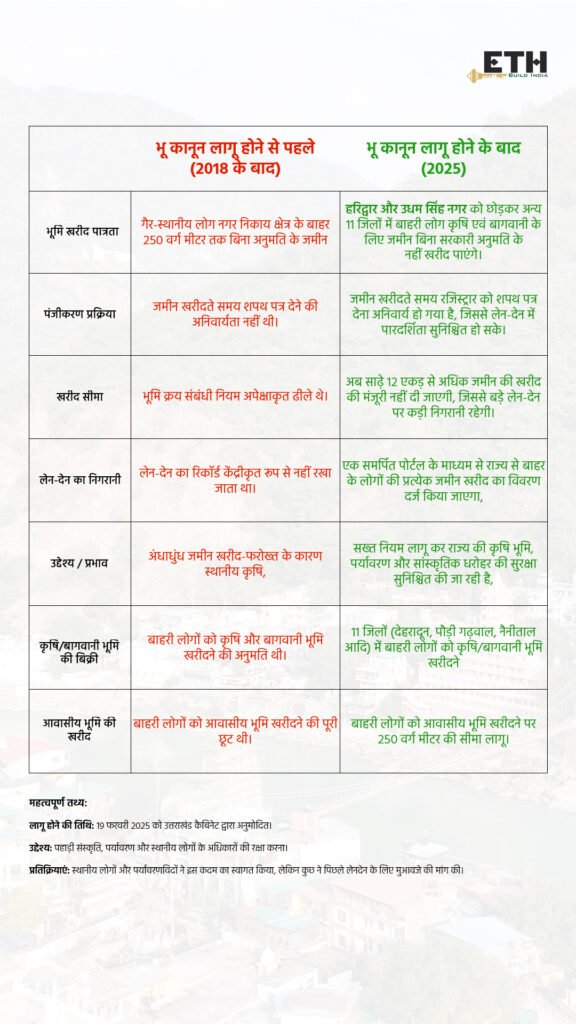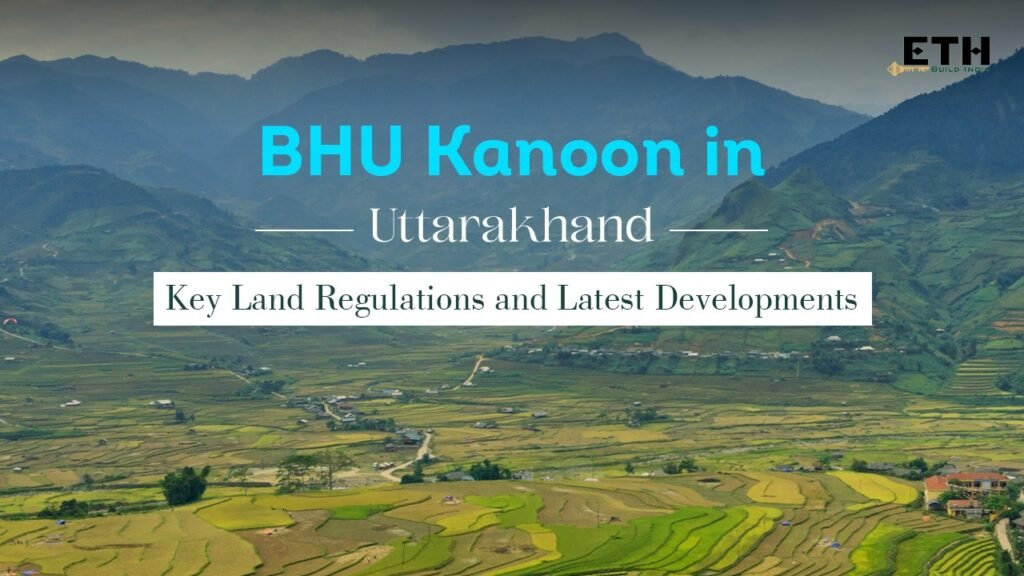Uttarakhand, a northern part of India, is a place with a really old and huge heritage, and obviously, one of the natural attractions of the region is the beauty of the place. But there is indeed something else to that landscape rather than only its nice views. Traditionally people have been practicing what they call “BHU Kanoon”.
These rules regulate the ownership of land, and its use. There is a huge matter affecting the aspects of ownership, farming, and landscaping in Uttarakhand. Also, the BHU Kanoon laws, among other things, give the land the appearance of a new and healthy one it is also a part of the lawsuit.
What is Bhu Kanoon?
The Hindi word “Bhu Kanoon” is the English translation for “land law,” and it is said to be the regulatory law of owning, keeping, and leasing land in Uttarakhand. These rules have been changing for hundreds of years, due to the changes in the local illegal activities that had been imposed by the British, and because of the introduction of new rules by government.
However, Bhu Kanoon has to do with different parts of managing land, and it also cover other things like:
- Land Tenure Systems: It is the categorization of land that reflects, who has the right to own it, like private owners, communities, or the government.
- Land Transfer and Registration: Rules and steps needed to buy, sell, and pass on land, along with the needed paperwork and registration.
- Land Use and Zoning: This is all about the rules for using different types of land: for farming, living, business, or factories.
- Dispute Resolution: There are ways to fix arguments about who owns land or how it’s used. Local village councils called panchayats and courts in the state handle these.
Latest News Update (February 2025)
On February 19, 2025, the Uttarakhand Cabinet approved a revised and stricter land law aimed at protecting the state’s agricultural and horticultural lands. This updated law—often referred to as a stricter version of the traditional BHU Kanoon—brings several new measures:

Restrictive Purchase Conditions:
With the new provisions, non-residents (except for those in Haridwar and Udham Singh Nagar) will no longer be able to purchase agricultural or horticultural land without explicit government permission.
Enhanced Verification Procedures:
Buyers from outside the state must now provide a mandatory affidavit during the purchase process, ensuring transparency and adherence to local land use policies.
Defined Land Purchase Limits:
The law also sets clear boundaries—for instance, only a limited area (such as up to 250 square meters for residential plots in Uttarakhand) can be acquired under these new regulations, and larger transactions will be subject to stricter scrutiny.
Historical Background
BHU Kanoon comes from the olden days. People in Uttarakhand used traditional rules for land and resource stuff. When the British ruled, they made these rules official and mixed them with proper laws. After India got its independence, the government tweaked the laws to tackle modern land issues but kept the old ways too.
What’s inside BHU Kanoon?
- Safeguarding Farmland: BHU Kanoon brings in rules to stop the free-for-all change of farmland to other uses. This is key to keeping our food supply steady and to keep farming going strong.
- Reforming Tenancy: These laws are all about giving tenants and folks sharing the land a solid deal. It’s about making sure they have somewhere to stay and getting paid right.
- Protecting Woods and Shared Spaces: This one is about rules to keep forests and places everyone can use safely. They’re super important for keeping nature in balance and helping local people make a living.
- Special Rules for the Hills: There are particular laws just for the hill areas in Uttarakhand. It’s because they’ve got their own set of nature and weather problems. They focus on keeping things going well up there without inviting disasters.
Changing Up How We Handle Land
BHU Kanoon is key in forming how people manage land in Uttarakhand. It controls how land is used and who owns it. This helps keep the environment healthy, makes sure folks have fair chances to access land and backs long-term growth. Plus, BHU Kanoon offers rules for settling fights over land, which helps keep things calm and peaceful around here.
Conclusion
BHU Kanoon stands as a witness to Uttarakhand’s awesome legacy when it comes to its legal stuff and how it handles land. With the region getting more city-like, these rules are super important so that people use land. If you’re dealing with land in Uttarakhand then you should be aware about the legalities of the state, including the BHU Kanoon and Agreement to Sale.
So, that was all you need to sort out who owns the land, how it should be used, and who gets to call the shots. By keeping up with changes and making sure rules are followed, BHU Kanoon is gonna keep being a major player in steering how land gets managed in this beautiful place.
FAQs
What is the Bhu Kanoon, and why was it revised in 2025?
The Bhu Kanoon is Uttarakhand’s land law regulating property ownership. The 2025 revision restricts non-residents from buying agricultural/horticultural land in 11 districts to protect local culture, prevent environmental degradation, and stabilize land prices.
Which districts are exempt from the new restrictions?
Only Haridwar and Udham Singh Nagar allow outsiders to purchase agricultural land. Residential purchases in these districts are capped at 250 sqm per buyer.
Can outsiders still buy residential property in restricted districts?
No. Non-residents are completely barred from buying agricultural/horticultural land in 11 districts. For residential purposes, even in restricted districts, approval is required via the state’s online portal.
How does the new law affect existing landowners from outside Uttarakhand?
Existing owners retain their rights, but new purchases in restricted districts are prohibited. Violations (e.g., fraudulent transactions) may lead to land repossession by the government.
What is the role of the centralized online portal?
All non-resident land transactions must be processed through a state-run portal to ensure transparency. District Magistrates (DMs) no longer have individual approval powers, reducing corruption risks.
Why did Uttarakhand take 24 years to implement strict land laws like Himachal Pradesh?
Earlier governments prioritized economic growth through relaxed land policies. The 2025 revision responds to rising public demand to curb demographic shifts and environmental damage caused by unchecked commercialization.
How does this law differ from the 2018 reforms?
The 2018 reforms eased restrictions, allowing DMs to approve outsider purchases. The 2025 law reverses this, centralizing control and banning agricultural sales in most districts.
Are there penalties for violating the Bhu Kanoon?
Yes. Unauthorized transactions or misuse of land (e.g., commercial use in residential zones) can result in government repossession, fines, or legal action.
Can outsiders lease land in restricted districts?
The law focuses on ownership, not leasing. However, long-term leases may require state approval to prevent exploitation.
When will the revised Bhu Kanoon come into effect?
The law was approved by the Cabinet on February 19, 2025, and is expected to pass in the assembly by February 24. Implementation begins immediately after formal ratification.





Those who are born in Dehradun and stayed to other place of India for some good reason, this law will make difficulties for them to come back to there birth place….now…
normal people get crushed in such situation when law get changed….region wise…in a country.
I strongly believe – “we are Indians , hence we shall have right to buy land any where in INDIA” , Govt. shall be vigilant and come with robust process that seller wont get exploited by any means.
defining regional limits, Seller ultimately get exploited by the locals only in time of need to sell their property…….
It’s a set back to the growth of the region and hence to country as well….
e.g. if anyone want to invest in resort form outside Uttarakhand , he can’t buy the suitable reasonable land in remote ideal location….and nor he can afford the costly land with city / Nagar Nigam lands….
Sorry if hurted unknowingly to any one.
thanks for reading.